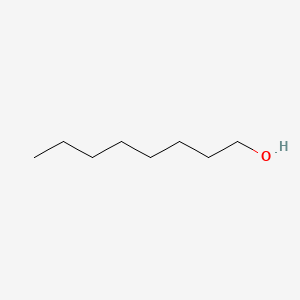| MeSH term | MeSH ID | Detail |
|---|---|---|
| Hemolysis | D006461 | 131 associated lipids |
| Lung Neoplasms | D008175 | 171 associated lipids |
| Colitis | D003092 | 69 associated lipids |
| Body Weight | D001835 | 333 associated lipids |
| Hypotension | D007022 | 41 associated lipids |
| Prostatic Neoplasms | D011471 | 126 associated lipids |
| Melanoma | D008545 | 69 associated lipids |
| Glioma | D005910 | 112 associated lipids |
| Leukemia P388 | D007941 | 43 associated lipids |
| Bradycardia | D001919 | 13 associated lipids |
n-octanol
N-octanol is a lipid of Fatty Acyls (FA) class. N-octanol is associated with abnormalities such as Wiskott-Aldrich Syndrome. The involved functions are known as Mutation and Detergents. N-octanol often locates in Tissue membrane. The related lipids are Octanols and 1-Octanol.
Cross Reference
Introduction
To understand associated biological information of n-octanol, we collected biological information of abnormalities, associated pathways, cellular/molecular locations, biological functions, related genes/proteins, lipids and common seen animal/experimental models with organized paragraphs from literatures.
What diseases are associated with n-octanol?
n-octanol is suspected in and other diseases in descending order of the highest number of associated sentences.
Related references are mostly published in these journals:
| Disease | Cross reference | Weighted score | Related literature |
|---|
Possible diseases from mapped MeSH terms on references
We collected disease MeSH terms mapped to the references associated with n-octanol
PubChem Associated disorders and diseases
What pathways are associated with n-octanol
There are no associated biomedical information in the current reference collection.
PubChem Biomolecular Interactions and Pathways
Link to PubChem Biomolecular Interactions and PathwaysWhat cellular locations are associated with n-octanol?
Visualization in cellular structure
Associated locations are in red color. Not associated locations are in black.
Related references are published most in these journals:
| Location | Cross reference | Weighted score | Related literatures |
|---|
What functions are associated with n-octanol?
Related references are published most in these journals:
| Function | Cross reference | Weighted score | Related literatures |
|---|
What lipids are associated with n-octanol?
Related references are published most in these journals:
| Lipid concept | Cross reference | Weighted score | Related literatures |
|---|
What genes are associated with n-octanol?
There are no associated biomedical information in the current reference collection.
What common seen animal models are associated with n-octanol?
There are no associated biomedical information in the current reference collection.
NCBI Entrez Crosslinks
All references with n-octanol
Download all related citations| Authors | Title | Published | Journal | PubMed Link |
|---|---|---|---|---|
| Davies DJ et al. | Further development of an in vitro model for studying the penetration of chemicals through compromised skin. | 2017 | Toxicol In Vitro | pmid:27751951 |
| Dave RA and Morris ME | A quantitative threshold for high/low extent of urinary excretion of compounds in humans. | 2016 | Biopharm Drug Dispos | pmid:27122230 |
| Harris S et al. | Phthalate metabolism and kinetics in an in vitro model of testis development. | 2016 | Toxicol In Vitro | pmid:26689326 |
| Xie Y et al. | Exploring bubble oscillation and mass transfer enhancement in acoustic-assisted liquid-liquid extraction with a microfluidic device. | 2015 | Sci Rep | pmid:26223474 |
| Damaraju S et al. | The role of gap junctions and mechanical loading on mineral formation in a collagen-I scaffold seeded with osteoprogenitor cells. | 2015 | Tissue Eng Part A | pmid:25752490 |
| Zahratka JA et al. | Serotonin differentially modulates Ca2+ transients and depolarization in a C. elegans nociceptor. | 2015 | J. Neurophysiol. | pmid:25411461 |
| Liu D et al. | Hydrophilic organic/salt-containing aqueous two-phase solvent system for counter-current chromatography: a novel technique for separation of polar compounds. | 2014 | J Chromatogr A | pmid:24999067 |
| Kupetz E and Bunjes H | Lipid nanoparticles: drug localization is substance-specific and achievable load depends on the size and physical state of the particles. | 2014 | J Control Release | pmid:24933601 |
| Oğuz M and Mihçiokur H | Environmental risk assessment of selected pharmaceuticals in Turkey. | 2014 | Environ. Toxicol. Pharmacol. | pmid:24929476 |
| Xu S and Kropscott B | Evaluation of the three-phase equilibrium method for measuring temperature dependence of internally consistent partition coefficients (K(OW), K(OA), and K(AW)) for volatile methylsiloxanes and trimethylsilanol. | 2014 | Environ. Toxicol. Chem. | pmid:25242335 |
